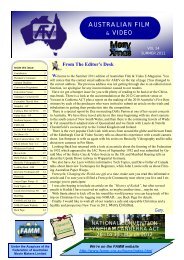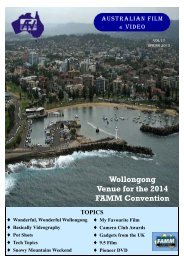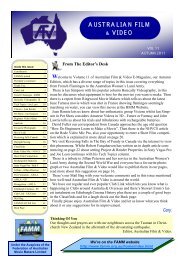Australian film - Federation of Australian Movie Makers
Australian film - Federation of Australian Movie Makers
Australian film - Federation of Australian Movie Makers
Create successful ePaper yourself
Turn your PDF publications into a flip-book with our unique Google optimized e-Paper software.
SUCCESSFUL MOVIE MAKING<br />
By John Hussell<br />
SUCCESSFUL MOVIE MAKING<br />
The success <strong>of</strong> your movie depends almost as much on the pictorial quality <strong>of</strong> the individual shots as on<br />
their dramatic content. This has been said before. The language <strong>of</strong> the movie is pictures. It is therefore easy<br />
to understand that the better the picture shown in the <strong>film</strong> the greater its audience-appeal.<br />
Use only the very best vision for your scenes. This requires some care. First <strong>of</strong> all, you must learn how to<br />
arrange your shot most effectively in the frame <strong>of</strong> the viewfinder, using the rule <strong>of</strong> two thirds. In every<br />
scene the audience's attention must immediately be drawn to the significant object or person The scene<br />
must be arranged that the person or object is brought into prominence and that disturbing elements are suppressed.<br />
MOVEMENT IS IMPORTANT IN MOVIES<br />
Only movement can hold your audience's eye and make an action easy to follow even without the spoken<br />
word, there are three kinds <strong>of</strong> movement to be considered,<br />
Movement into the scene,<br />
Movement out <strong>of</strong> the scene,<br />
Movement within the scene.<br />
MOVEMENT WITHIN THE SCENE.<br />
This arises in actions involving hardly any change <strong>of</strong> place e.g. tea parties, conversations, card games,<br />
dancers. Children playing etc. you only need to bring the significant object or person into the middle <strong>of</strong> the<br />
picture<br />
MOVEMENT INTO OR OUT OF THE SCENE<br />
There must always be room for the moving object or person to move into; the speed <strong>of</strong> the movement, its<br />
direction with relation to the camera, and the distance <strong>of</strong> the moving object or person from the camera are<br />
all important.<br />
A ladybird crawling past the lens <strong>of</strong> the camera one foot away may go in and out <strong>of</strong> the picture more<br />
quickly than an express train rushing along two miles away, because the train is moving very slowly to the<br />
eye. Slow movement has become apparently fast and fast movement very slow. The position <strong>of</strong> the camera<br />
relative to the direction <strong>of</strong> movement determines how long the moving object will remain within the field<br />
<strong>of</strong> view. Sometimes the object remains in the picture for so long that it seems to lose its speed altogether, a<br />
train in the middle distance traveling almost directly towards the camera. Takes a long time for it to reach<br />
us and rush past.<br />
Similarly if you <strong>film</strong> a skier or board rider at an acute angle to his direction <strong>of</strong> movement, you can keep<br />
him in the picture for longer than if you <strong>film</strong> him at right angles. In the latter case he would simply flash<br />
past the camera.<br />
THREE FACTORS ARE VERY IMPORTANT IN ARRANGING A SCENE, ESPECIALLY IF<br />
THERE IS MOVEMENT<br />
• Range.<br />
• Angle <strong>of</strong> view <strong>of</strong> the lenses.<br />
• Direction <strong>of</strong> view.<br />
Page 52<br />
<strong>Australian</strong> <strong>film</strong> & video










